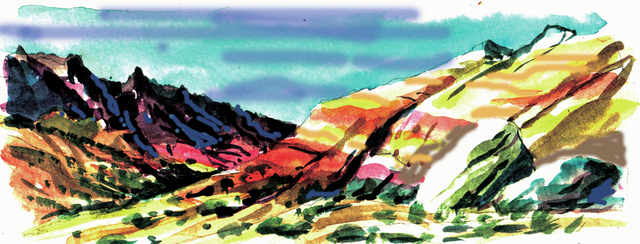Explore unique geology of Rainbow Basin area

The eroded, fossil-laden landscape of the Rainbow Basin Natural Area north of Barstow, Calif., invites exploration of its multicolored formations, winding desert canyons and washes with areas of dense vegetation.
Rainbow Basin offers camping, hiking, scenic touring, wildlife watching, photography and more. It’s best to visit the area during the cool seasons.
Rainbow Basin is eight miles north of Barstow. From Las Vegas, follow Interstate 15 south for 160 miles to Bartstow. Exit the freeway onto Barstow Road and follow it to Main Street. Turn left and drive a short distance to First Avenue. Follow this street north briefly to Irwin Road and turn left. Follow Irwin Road out of town, watching for a sign for Rainbow Basin. Turn left on unpaved Fossil Bed Road. Head west for about three miles to a spur road. It accesses both the Owl Canyon Campground and the one-way Fossil Canyon Loop.
Listed as a National Natural Landmark, Rainbow Basin is named for its colorful geological formations and mineralized earth exposed by erosion. Vulnerable landscapes and fossil resources also make it an area of critical environmental concern. The Bureau of Land Management administers this region of public and private lands, including portions of the Southern Pacific Railroad, mining interests and ranches with grazing rights.
Rainbow Basin looks much the same as it did when the railroad arrived more than a century ago. Despite its proximity to a growing area, it seems remote. The BLM strives to keep it that way. Development is limited to the 31-unit campground at the edge of Owl Canyon, the single lane of the scenic loop road and the graded access road.
To prevent further degradation of the landscape and damage to the fossil areas, the BLM has closed old tracks to motorized use and encourages the use of foot trails in the canyons and washes. Shooting and hunting are not allowed. The agency prohibits off-roading in the natural area. Off-roaders enjoy unimpeded access to off-highway vehicle routes in other areas not far away, such as Stoddard Valley, Johnson Valley and Dumont Dunes.
Such policies have improved habitat for native birds and wildlife, returning them to cliffs and to Owl, Coon and Fossil canyons. Because of their protective walls, occasional water and thick vegetation, the small canyons attract a variety of birds and elusive desert creatures. Wildlife watching is most rewarding early in the day or toward dusk.
The Owl Canyon Campground offers simple sites with a parking pad, sheltered table and cooking grill or campfire grate. They are available on a first-come basis for $6 a night. There are no hookups for RVs. Bring water and firewood and plan to bag up refuse for disposal at home.
It’s best to drive a high-clearance vehicle on the narrow, curvy, one-way road through Fossil Canyon. Signs warn against driving motorhomes or vehicles towing trailers.
The loop road accesses areas where erosion exposes fossils deposited over millions of years on the bottom of a vast lake. The creatures became trapped in mud that eventually turned to stone.
The fossils are protected from casual collectors. Only those with professional or institutional interest in fossils may take them from the fossil beds, after obtaining collection permits from the BLM field office in Barstow. These fossil deposits are frequently used for university field trips. Visitors inspecting the fossil beds should pull safely off the road and explore on foot.
Margo Bartlett Pesek’s column appears on Sundays.